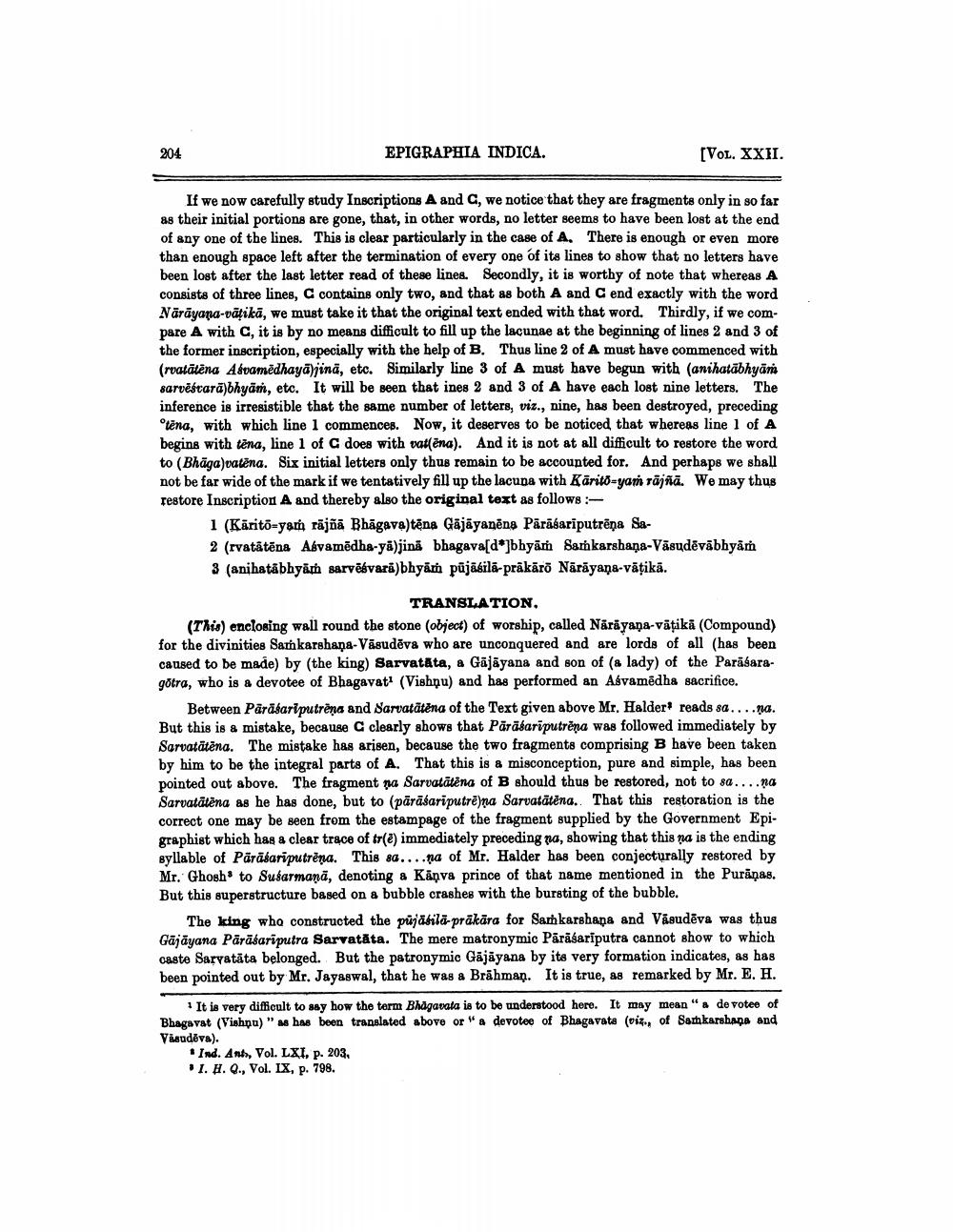________________
204
EPIGRAPHIA INDICA.
[VOL. XXII.
If we now carefully study Inscriptions A and C, we notice that they are fragments only in so far as their initial portions are gone, that, in other words, no letter seems to have been lost at the end of any one of the lines. This is clear particularly in the case of A. There is enough or even more than enough space left after the termination of every one of its lines to show that no letters have been lost after the last letter read of these lines. Secondly, it is worthy of note that whereas A consists of three lines, C contains only two, and that as both A and C end exactly with the word Nārāyana-vātikā, we must take it that the original text ended with that word. Thirdly, if we compare A with C, it is by no means difficult to fill up the lacunae at the beginning of lines 2 and 3 of the former inscription, especially with the help of B. Thus line 2 of A must have commenced with (rvatātēna Aévamēdhayā)jină, etc. Similarly line 3 of A must have begun with (anihatābhyāna sarvēstarā)bhyān, etc. It will be seen that ines 2 and 3 of A have each lost nine letters. The inference is irresistible that the same number of letters, viz., nine, has been destroyed, preceding tēna, with which line 1 commences. Now, it deserves to be noticed that whereas line 1 of A begins with tēna, line 1 of C does with vat(ena). And it is not at all difficult to restore the word to (Bhāga)vatêng. Six initial letters only thus remain to be accounted for. And perhaps we shall not be far wide of the mark if we tentatively fill up the lacuna with Kärito-yan rājña. We may thus restore Inscription A and thereby also the original text as follows:
1 (Kärito-yam rājña Bhagava)tēna Gäjäyanēns Päräsariputrēna Sa2 (rvatātēna Abvamēdha-ya)jină bhagava[de]bhyām Samkarshana-Vāgudēvābhyām 3 (anihatábhyam sarvēsvara)bhyām pūjāsilā-prākāro Nārāyana-vātika.
TRANSLATION, (This) enclosing wall round the stone (object) of worship, called Närāyaṇa-vātikā (Compound) for the divinities Sarkarshana-Väsudēvs who are unconquered and are lords of all (has been caused to be made) by (the king) Sarvatata, a Gājāyana and son of (a lady) of the Parāśaragotra, who is a devotee of Bhagavat? (Vishnu) and has performed an Advamedha sacrifice.
Between Pāräsariputrēna and Sarvatātēna of the Text given above Mr. Halder reads sa....na. But this is & mistake, because C clearly shows that Pārāsariputrēna was followed immediately by Sarvatātēna. The mistake has arisen, because the two fragments comprising B have been taken by him to be the integral parts of A. That this is & misconception, pure and simple, has been pointed out above. The fragment na Sarvatātēng of B should thus be restored, not to sa....na Sarvatätena as he has done, but to (pārāsariputrē) na Sarvatätena. That this restoration is the correct one may be seen from the estampage of the fragment supplied by the Government Epigraphist which has a clear trace of tr(ë) immediately preceding pa, showing that this na is the ending syllable of Pārāsariputrēna. This sa....na of Mr. Halder has been conjecturally restored by Mr. Ghosh to Sušarmană, denoting & Kāņva prince of that name mentioned in the Purāņas. But this superstructure based on a bubble crashes with the bursting of the bubble.
The king who constructed the půjätila prākāra for Sarkarshana and Viaudēva was thus Gājāyana Pārāsariputra Sarvatata. The mere matronymic Pārāśariputra cannot show to which caste Sarvatāta belonged. But the patronymic Gājāyana by its very formation indicates, as has been pointed out by Mr. Jayagwal, that he was a Brāhman. It is true, as remarked by Mr. E. H.
It is very difficult to say how the term Bhagavata is to be understood hero. It may mean" a devotee of Bhagavat (Vishnu)" has been translated above or "a devotee of Bhagavata (viz., of Samkarshapa and Vasudeva).
IM. An, Vol. LỢI, P. 203 1. H. Q., Vol. IX, p. 798.




